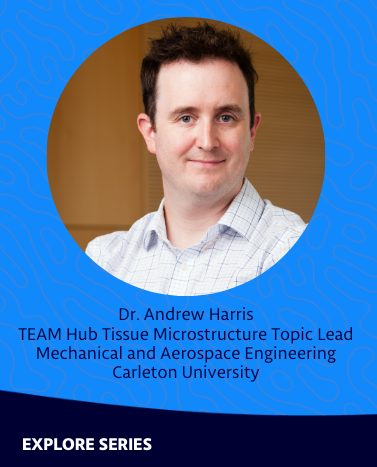Seminars Series
Join us for our monthly seminar series:
'Explore' & 'Research in Progress'
Development and validation of microfluidic chip and 3D bioprinted tissue models for therapeutic screening
Blood-brain barrier (BBB) models in vitro are crucial tools to aid in the pre-clinical evaluation and selection of BBB-permeant biotherapeutics. Human induced pluripotent stem cell (iPSC) derived brain endothelial-like cells (iBECs) have demonstrated a substantial advantage over primary and immortalized brain endothelial cells for BBB modeling. We developed a 3D BBB-on-Chip co-culture model to model critical components of the BBB. We established iBEC microvessel lumens under physiological in vivo shear stress conditions in the apical channel of the chips, while human primary astrocytes and pericytes were cultured on the basolateral side separated by a porous 3 μm membrane. We deployed this BBB-on-Chip model to study antibody-triggered receptor-mediated transcytosis by perfusing the iBEC lumens with a well-characterized single domain BBB-carrier FC5-Fc and non-crossing A20.1 control. We also leveraged microfluidic-based 3D bioprinting technology and alginate-collagen type I (AGC)-based bioinks to fabricate a complex vascular network comprised of SV40 transformed adult rat brain endothelial cell (SV-ARBEC)-laden hydrogel rings with mechanical properties relevant for neurovascular tissue engineering applications. ECM remodelling confirmed SVARBEC-mediated collagen type I fiber deposition and reorganization leveraging second harmonic generation (SHG) microscopy. These platforms aim to better recapitulate the physiological characteristics of the tissues in vivo and offers a more predictive platform for therapeutic screening.
Where? Virtual (Zoom): 913 5904 4139 @ 12 PM
February 26th, 2024

Blood Brain Barrier Models In Vitro - Advancing Central Nervous System Drug Discovery
Central nervous system (CNS) drug development is hindered by high clinical attrition rates. The complex physiology of the human brain, the difficulty in achieving sufficient drug concentrations in the brain and inadequate animal models of human CNS pathology are key underlying causes. Combining human induced pluripotent stem cells, microfluidic organ on chip and 3D bioprinting technologies are key to developing translational and predictive models for assessing blood-brain barrier (BBB) permeability and advancing CNS drug discovery.
Where? ME 3356 @ 12 PM
POSTPONED: March 25th, 2024

The Dynamics of the Intestinal Epithelium (with Imaging of Intestinal Organoids!)
The intestinal epithelium is instrumental in taking up food and water and keeping pathogens at bay by providing an important barrier. One of the ways it can execute this dual role is by completely renewing itself every week or so. This renewal process is driven by intestinal stem cells and allows for rapid changes in epithelial composition upon challenges such as infection. Organoids mimic their tissue counterpart and can be used to model such diseases in the lab. The rapid renewal of the intestinal epithelium is nearly completely replicated in lab-grown intestinal organoids. Our lab is interested in how the epithelium comes about during the postnatal stage and how it is involved during immunity to infection. I will highlight our recently published and unpublished work.
Where? NI 3040 @ 12 PM
November 27th, 2023

Engineering the Mechanical Properties of Cells and Tissues
Exposure to mechanical stresses is a normal part of physiology for cells and tissues. Consequently, maintaining mechanical properties that give cells and tissues a combination of strength and durability is critical for their proper function. This is most apparent in diseased states, where genetic mutations to cytoskeletal and intercellular adhesion proteins alter mechanical properties and result in phenomena associated with cell and tissue mechanical failure. We have been developing new experimental tools for characterizing cell and tissue rheology at the millimeter and micron scale are providing new biophysical insights into this unique form of active matter. These properties can be traced to the nanometer scale, and I will present recent work that has uncovered how proteins associated with the actin cytoskeleton and intercellular adhesions dynamically organize into distinct structures that underly cell and tissue mechanical properties. This combination of experimental tools and analytical techniques from engineering and the physical sciences, with classical molecular biology and biochemistry, is now poised to enable a fundamental understanding of cell mechanics that is rich in complex biophysical phenomena and will guide novel therapeutic strategies.
Where? ME 3275 @ 12 PM
October 30th, 2023

The Explorer Series

The Explorer Series is a dynamic seminar series that brings together researchers from diverse academic fields to share their groundbreaking work. This series serves as a melting pot of ideas, fostering collaboration and innovation across various disciplines. From cell biology to engineering, attendees will have the opportunity to delve into the latest discoveries, methodologies, and insights from leading researchers, promoting cross-pollination of ideas and sparking new avenues of exploration.
Research In Progress Series

Our Research in Progress Series features presentations from students and trainees eager to showcase their research and expertise. This series provides a platform for the next generation of researchers to share their work. From undergraduates to graduate students and early-career professionals, attendees can expect a diverse array of topics and fresh perspectives. The series fosters a supportive environment for constructive feedback and networking, helping young academics develop their presentation skills and connect with peers who share their passion for advancing knowledge.